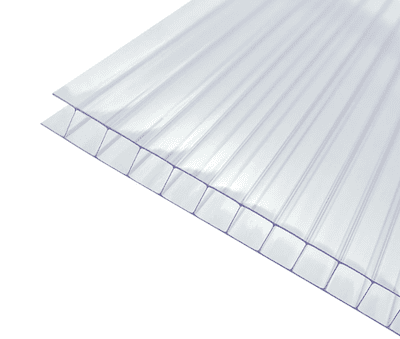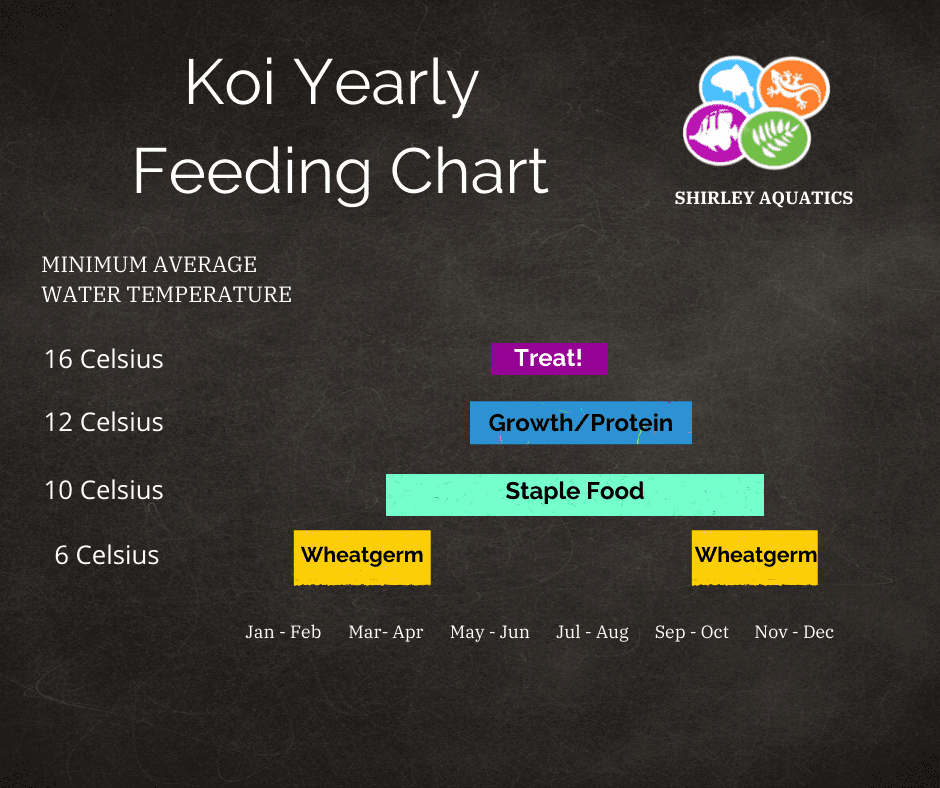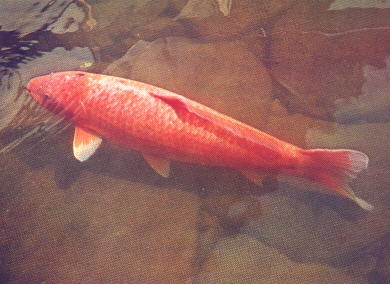Koi for dummies – our practical guide to koi keeping
13 min read
Koi for Dummies covers everything useful you need to know about koi keeping. From set up and hardware, through to diet, and welfare.
If you’re looking for some practical advice on a specific area of koi keeping pick from the links below. If you’re brand new to the hobby there are a few things you’ll need to know and have in place before you start. The very first thing you need to do is as much research as you can about keeping koi. Koi for Dummies is your starting point. This should give you an excellent grounding but there’s always more to learn!
- The koi pond
- koi pond hardware
- koi water quality
- How big do koi get?
- What do koi eat?
- How long do koi live?
- What can I keep with koi?
- What plants can I have with koi?
- How much do koi cost?
- Koi care
The koi pond #
Koi for Dummies top tip – get that water moving. #
The size and shape of your pond are critical to how easy or difficult it is going to be to keep koi successfully. The single most important element of your pond is water circulation. We’ve covered this briefly in Top 10 Tips for perfect Koi Keeping.
Circulation is not just great for oxygenation and the general enrichment of your fish, it moves waste. Koi produce an awful lot of waste and it all needs to go somewhere. Plenty of circulation to carry this waste to your bottom drain is essential for good water quality and healthy, happy fish. It’s important to ensure all of your water is moving, particularly the bottom 6 to 12 inches.
“Your crap at the bottom won’t grow legs and walk itself to the drain”
Anonymous staff member
We see many ponds with great circulation in the top half but this fades to almost nothing at the bottom. The result is sludge, potential build-up of ammonia, and a breeding ground for bacteria and parasites.
The best shape for this great circulation is a hemisphere – imagine half a football or a fancy hand basin – with a drain in the bottom. The problem is many people don’t like the idea of a circular pond. Rounding off all the corners you can and having sloping sides to encourage waste towards the bottom centre is best practice.

Size Matters #
There are lots of rules of thumb about how many fish you can have in your pond. These are mainly ignored as 99% of ponds are overstocked with fish. The ‘rules’ around water volumes (i.e. 1,000 litres of water per koi) start to come apart a bit when you ask what size of koi this refers to.
Basically, have fewer fish that you originally wanted and look after them well. A large pond with a few big, healthy fish looks a lot better than something packed with small fish you can’t keep alive for more than a few years each.
The golden rule is to know your volume. You can’t really make any big decisions without that. How to work it out? Take your length, width, and depth and multiply them together. Then times that by 6.25 for your gallons, then times THAT by 4.5 for your litres!

Koi Pond Hardware #
Koi for Dummies top hardware tip – Go Bigger #
How to turn a normal pond into a koi pond? Make everything bigger. Filters need to be juiced up, aerating bottom drains need to be introduced, big flow rates on pumps – big everything.
We use aerating bottom drains in our big koi ponds – you’ll see the column of bubbles coming up from the floors. These are connected to the water pipes under the ponds with an airline running parallel to introduce oxygen. This way of doing it reduces the amount of cables and pipes running in and out of the side of your pond.
Koi pond pumps and filters #
Koi for Dummies top pump tip – one pump per job. #
If you’ve been getting by with a fountain pump up until now, or an all-in-one unit then you will need to upgrade your pump and filter. There are two types of pumps – pressure and filter-feeding. If you run a pressure pump, like those used for fountains or small waterfalls, to your filter it will become clogged in no time at all and stop working.
Filters will often say on the box how many litres they are designed to deal with. If you’re keeping Koi you need to, as a minimum, quarter that number. For example, if a filter says it deals with 20,000 litres of water it will handle a pond of about 5,000 litres with koi in it at the absolute maximum. One of the reasons we love OASE so much is that they are one of the only manufacturers who recognise this and reference it to all their customers.

The filter might also give a recommended flow rate. You’ll need a pump that can easily match that number. For example, if a filter recommends a flow rate of 2,000 litres per hour you’ll need a pump that can deliver around 3,000 litres per hour and have it running at 60-70% capacity; rather than one working flat out all of the time.
UV #
Koi for Dummies top UV tip – replace your UV bulb every 12 months. #
You will need a UV unit when setting up a pond and this is doubly true for koi. The UV bulbs kill bacteria and algae in your water as it passes by the bulb and needs replacing every 12 months. Many filters have UV clarifiers built into the filter unit, you can also buy separate UV clarifiers that can be placed ‘in-line’ with your hosing like the Evolution Aqua UV Clarifiers. Evolution Aqua started in Wigan 17 years ago as Koi filtration specialists. Their pond products are almost exclusively conceived, designed, and manufactured in the UK.
Here’s a bonus Koi for Dummies top tip – if you have a UV clarifier in your filter the bulb will be housed in a clear tube. This is called the Quartz Sleeve. They’re frighteningly expensive so be as careful as you can when you’re removing them to replace the bulb. Check for every conceivable way you could get the bulb out before trying any of them.
Theoretically, once your pond is established and stable you can do without the UV but this can take years to achieve and it’s generally considered an unnecessary risk.
Wintering your koi #
Koi for Dummies top tip – keep that filter on! #
If anyone tells you that you can turn your filter off over winter they either don’t know what they’re talking about, have been incredibly lucky so far, or both.
At least 60% of ammonia in a pond comes from the gills and the breathing process of fish. Koi may go dormant during the colder months but they don’t stop breathing. Therefore your filter must stay on. Shut off or bypass fountains, sprays, and light flows of water. Even if they don’t freeze solid they’ll be losing lots of heat and introducing much colder water into your pond’s main body – which you don’t want.

A great tip for maintaining some stability over winter is to use twinwall polycarbonate sheets and make a ‘tent’ over the pond. It doesn’t have to be the best tepee in the land, just something to retain some heat. These allow air circulation above the pond but will raise the air temperature a little bit and maintain some consistent air over your pond. This is particularly handy if your garden or land is subject to northerly winds over winter. Make sure to use the sheets that allow UV through and do not seal the top of the pond. This will stop oxygen transfer and kill your fish.
Koi water quality #
Koi for Dummies top water tip – crystal clear does not mean all is well! #
“I don’t keep koi, I keep water.”
Ron – our resident koi lover
If you’re new to koi or pond-keeping in general you’ll need to spend some time making sure your water is right before you even think about adding fish to it. Fair warning, this could take months. Water parameters are very important in fish-keeping in general. You’ll need to test for pH, KH, Nitrate, Nitrite, and Ammonia every week to make sure your parameters are stable. A fluctuation in any of these can spell disaster if not addressed quickly.
When you’re setting up a new pond or new filter then these elements will also affect how quickly the filter reaches maturity. That means how quickly you can build up a beneficial bacterial colony in your filter and get your water parameters under control. Remember, crystal clear water is not necessarily a sign that everything is fine!
Water testing should not be considered optional, particularly when keeping koi. We recommend buying the API Freshwater Test Kit. Testing every week, this kit should last you about 18 months and works out far cheaper in the long run than grabbing small sets of test strips every few weeks.
How big do koi get? #
Koi will average out at around 60/65cm when fully grown. However many can go bigger. Our own two giants, Buttercup and Florence, are both above 90cm each. You can influence this to a certain degree by maintaining good water quality, high circulation, high-quality food, and a steady temperature.
Their main growth spurts will happen between 2 and 3 years old. But, as with many koi ‘facts’, there are many fish that will take a few years longer to hit but growth spurts. By the time they get to 12-15 years old, they’ll likely have reached their maximum size.
What should I feed koi? #
Koi for Dummies top feeding tip – fish can only take up a set amount of protein at a time. Slamming your fish full of high-protein foods in the winter months will result in all that extra ‘goodness’ being excreted by your fish instead of being used. Follow our feeding chart. #
There is plenty of koi food options in pellet form, all of them perform slightly different tasks and should be used at different times – see below

On top of this, there are plenty of treats that koi adore. Muscles, cockles, and bloodworms are all favourites. A quartered orange is a welcome treat and koi will spend time chasing the segments around the surface of the water whilst getting their vitamin C. They love a bit of honey drizzled on their food, too. They even ate half a pork pie that was carelessly dropped in our pond a few weeks ago!
For some of the best growth and most vibrant colouration on koi you should consider giving them a wide and varied diet.
How old will a koi get? #
Koi for Dummies top tip – Koi last a long time and are a big commitment. They’ll comfortably outlive a dog. Be sure you want them. #
A captive koi’s lifespan is around 30 years. Japanese koi that remain in Japan will reach around 40 provided they’re not moved. Wild river carp have been known to reach 90 years old.
The oldest recorded koi was called Hanako and she reached the staggering age of 226. As they age Koi develop rings on their scales like trees. In 1977 two scales were taken from Hanako and examined at a medical facility in Japan. She was confirmed to be 217 at the time and died 9 years later. She wasn’t particularly striking in terms of patterns, was slightly larger than standard at 70cm long, but is a very impressive fish nonetheless.

What can I keep with koi? #
Whatever you like. They’re not shoaling fish but they’ll tolerate pretty much any neighbours. Orfe, Tench, Goldfish, and Sturgeon are all good options. One word of warning with Sturgeon – unless you’re confident you can maintain perfect water don’t get Sturgeon. They are very sensitive to changes in parameters and can be very tricky to keep at an amateur level.
What plants can I have with koi? #
Koi for Dummies top plants tip – if it floats you’re generally ok. Other than that they’ll dig it up in a heartbeat. #
Anything you like as long as you’re planning on how to keep it in the floor. Koi are notorious for digging up plants and rooting around. They’re capable of moving extremely heavy rocks and if they decide they want a plant out it’s coming out. There’s a reason they’re called pond pigs.
If you want plants in your pond that are rooted in the bottom you will need to have a very proactive approach to maintaining your substrate, soil, and rooting of your plants. We’d also recommend some way to keep Koi off the bottom of the plants to prevent them uprooting them. Metal cages is often the only thing that works.
Floating plants or floating baskets normally fare better and can provide some beautiful visual elements to your pond.
How much are koi to buy? #
How long is a bit of string? It depends on the size, breed, and age of the Koi in question. Anywhere from around £16 to several thousand pounds. If you’re worried about how much the fish cost you have some unpleasant news headed your way when it comes to hardware and upkeep!
Koi care #
Koi for Dummies top care tip – invest in a microscope and some slides. Identifying problems early make all the difference to treatments. #
As with any animal husbandry there will be an element of care and medication you’ll need to be aware of. If you’re not in the position to administer care to your koi, or don’t know enough about it, you will need to find someone (like us!) who can help you with it.
Koi can suffer from all sorts of maladies from cosmetic cuts, bruises, and rips, to parasites and bacterial infection. The signs of these issues are flashing, jumping, clamping (where the fins are held tight to the body), and excess mucus production. The downside is that these signs are fairly uniform no matter what the issue so there’s no real way of knowing what the exact issue is from thse behaviours alone.
You can either learn how to identify koi issues yourself, buy a microscope and some slides, and get to it yourself or get in touch to ask us. We’re often taking samples and ‘scrapes’ from our fish to check on their health. It’s fair to say that you will, at some point, encounter problems. Making sure you’ve done enough research to at least recognise the signs is the bare minimum you should be doing if you want to successfully keep koi.






